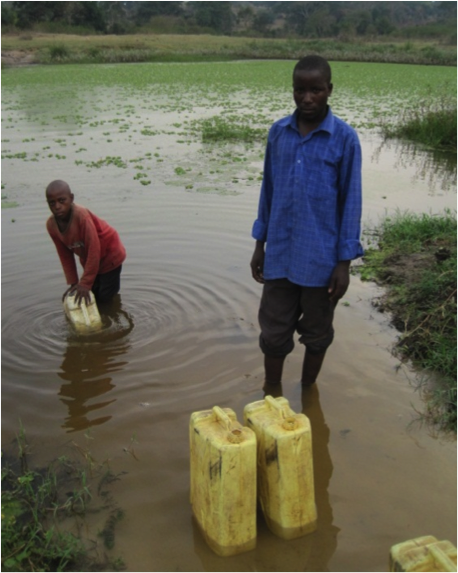Securing safe water in sub-Saharan Africa
Securing safe water in sub-Saharan Africa
Adam Harvey, Director of Whave Solutions, proposes an innovative model to incentivise the maintenance of safe water sources together with adequate hygiene. The model is currently piloted in several districts in Uganda.
The problem of unsafe water affects rural communities and cities around the world. Diarrheal diseases are closely associated with contaminated water and result in the deaths of 1.4 million children annually. Approximately half of all people globally who lack access to safe drinking water live in sub-Saharan Africa.
Climate change is exacerbating the problem. Currently more than three-quarters of Africa’s drinking water comes from groundwater, much of which is consumed from unprotected sources such as open ponds, springs or streams. The quality of this water is declining as rainfall patterns change and population density increases in rural areas and slums, causing increased levels of contamination through out-dated or inadequate sanitation and hygiene practices.
The prevalence of debilitating disease accentuates the vulnerability of rural subsistence farmers to climate change; it reduces productivity and educational achievement and absorbs disposable income in medical and funereal costs. One of the key features of climate compatible development is resilience to climate change and a key component of resilience is elimination of unsafe water from the lives of subsistence farmers.
[caption id="attachment_28693" align="alignright" width="239"] A common scene in rural Uganda; in places where protected water sources already exist but are not functioning.[/caption]
A common scene in rural Uganda; in places where protected water sources already exist but are not functioning.[/caption]
Nominally, access to safe water is around 60% in many sub-Saharan countries, but there is a serious concern that the real figure is dramatically less if poor functionality is taken in to account, and near zero in many areas when hygiene considered. A large number of agencies install protected water sources and provide local management and hygiene training, but the evidence is that hygiene levels remain inadequate and after a relatively short period of time too many installations become non-functional. A huge portion of the protected sources that have been installed in the past 20 years by governments and voluntary bodies, have fallen into disuse. Traditional hygiene practises persist despite educational programmes.
One potential reason for these persistent threats is that there are no financial incentives in place to maintain safe water sources and home hygiene. Where will finance for such incentives come from? If most rural Africans were willing and able to pay for safe water, the answer would be simple: the water users themselves provide the financial incentive to motivate local professionals to provide safe water services. This condition is a common target of government and NGO strategies in this sector. Purchase of water from kiosks, payment per jerry can at the pump, chlorine dispensers, and so on, are solutions currently promoted by many agencies. In practice they are stalled by unwillingness of users to pay, and reversion by users to “free” water in contaminated ponds and streams.
A CDKN project, launched in February 2013, offers an innovative and practical solution tackling low-functionality and low-hygiene by providing financial incentives to professionals for supplying safe water and hygiene services. It also acts as a concrete demonstration of how results-based aid can work in practice. If social workers with hygiene training skills are paid according to the hygiene levels they achieve, and technicians are paid according the number of days the protected sources are functional, then local professionals have a source of income that depends on improved functionality and hygiene. It is possible that current arrangements provide no such incentive, and it is possible that this is a fundamental cause behind the continuing prevalence of water-borne disease. If outputs are measured accurately, and financial assistance is pinned to clear metrics, then finance can incentivise effectiveness.
The CDKN project also looks to emergent new instruments for development assistance to realise the ultimate target of user-payment. CDKN has contributed to the reform process for the Clean Development Mechanism (CDM), leading to instruments such as Results-Based Financing based on CDM-monitoring-protocols and Nationally Appropriate Mitigation Actions (NAMAs). This project provides ground-level examples of how such mechanisms could work in practice. The CDKN project therefore is piloting a structure under which Water Service Providers earn monthly fees proportional to actual achievements in functionality and hygiene in their concession areas. The finance is sought from development agencies, sovereigns, and corporate CSR departments who appreciate the need for transformational finance over a period of 10 to 20 years, and appreciate the value of development assistance based on payment for measured results.
The project has been designed by Whave Solutions Ltd, a social enterprise based in Uganda, with a staff history of development assistance world-wide in renewable energy and energy-assistance. It is being implemented by Whave in partnership with the government of Uganda and NGOs providing protected water sources and hygiene training. The pilot work will lead to a case study for use by policy makers in East Africa and sub-Saharan Africa. The pilot study was conceived by Whave in October 2011. Implementation started in Eastern Uganda in partnership with a major NGO, Busoga Trust, in July 2012. It is now active in three districts in Uganda and is expanding into further districts.
The project acts as a ground-up exercise in designing an effective national regulatory system for safe water assurance, and an example of output based aid, which will be of interest to other sectors. It could form the basis of a sectoral NAMA.
We occasionally invite bloggers from around the world to provide their experiences and views. The views expressed here are those of the author, and not necessarily those of CDKN.
For more information, visit the project page, or contact Adam Harvey, Director of Whave Solutions.
Main image (right) courtesy of World Bank photo library; other image from Adam Harvey.
